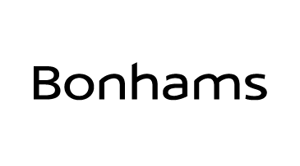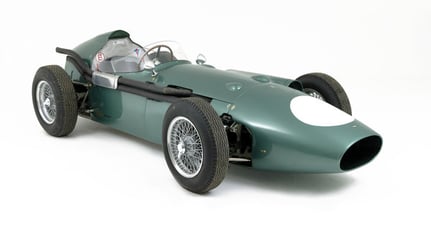1959 Aston Martin DBR4
-
Year of manufacture1959
-
Engine numberRB6/2501
-
Lot number316
-
DriveLHD
-
ConditionUsed
-
Number of seats2
-
Location

-
Exterior colourOther
-
Drivetrain2wd
-
Fuel typePetrol
Description
1959 Aston Martin DBR4/250 Formula 1 Monoposto Re-creation
Engine no. RB6/2501
It is familiar history today how the Aston Martin works team's ultimately World Championship-winning exploits in sports car endurance racing during the late 1950s also inspired in team patron David Brown the ambition to enter Formula 1, and to attack the Drivers' - and newly introduced Constructors' - World Championship competitions in parallel.
After a single-seat open-wheeled Formule Libre prototype car had been constructed and campaigned in New Zealand by Aston Martin's highly respected team leader, Reg Parnell, a serious Formula 1 programme was initiated although financial and technical restraints would see the pace of its progress being governed by the sports-racing DBR1/300 schedule that the Feltham racing department had to pursue at the same time.
Design of the Feltham racing department's new Formula 1 car was developed during 1957-58, following the classical Grand Prix configuration of a front-mounted engine driving a rear-mounted gearbox-cum-final-drive assembly. In this it was absolutely in line with perhaps the quintessential front-engined Grand Prix car design of the 1950s: the Maserati 250F. Except that here would be a Formula 1 car built to the painstaking standards of Aston Martin Lagonda Ltd.
The chassis structure chosen by the Aston design team was a very lightweight, fine-gauge tubular steel spaceframe, to be clad in typically handsome thin-gauge aluminium bodywork. Power was provided by a 2½-litre version of the marque's highly successful 3.0-litre six-cylinder twin-overhead-camshaft racing engine, and it drove via an exposed propeller shaft to the DBR1-type transaxle, mounted in line with the de Dion-type rear suspension.
Four of these DBR4/250 Formula 1 cars were to be produced - ultimately emerging at the start of the 1959 racing season - and they were campaigned during that year's Formula 1 World Championship by works drivers Ray Salvadori and Carroll Shelby. Salvadori achieved a notable 2nd place upon the new design's debut in the BRDC International Trophy race at Silverstone, but when unexpected sports car success persuaded David Brown to concentrate attention upon the parallel DBR1 sports car programme, it was inevitable that effort in Formula 1 would be relaxed. This was the right decision, as it enabled Aston Martin to achieve Brown's ambition by beating Ferrari and Porsche to that year's Sports Car World Championship title - becoming the first British marque to achieve this colossal honour.
When the surviving DBR4 cars ultimately found their way into Historic racing in the later 1960s/1970s, one of the cars - DBR4 chassis '1' - passed into the ownership of Aston Martin connoisseur Geoffrey Marsh, whose Marsh Plant company supported its highly successful appearances at Historic level, driven by Gerry Marshall.
The Specialist Car Division of Marsh Plant in Havant, Hampshire, had also owned the 1959 Le Mans-winning DBR1/300 at that time, and after it was sold Geoffrey Marsh approached the Vintage Sports Car Club concerning a new project, to recreate the long-lost Formula 1 DBR4 chassis '2' which had been broken up by the factory in period, the rebuild to absorb the myriad of original components, including a 2½-litre Formula 1 engine, 95-degree cylinder head and David Brown transaxle, which he had collected during Marsh Plant's period campaigning both DBR 1/300 and DBR4/1.
That reconstructed car - a replica of 'DBR4/2' - is now offered here, having been acquired by the current vendor at Bonhams & Brooks' second annual sale at Aston Martin Works Service, Newport Pagnell in May 2001 (Lot 193).
At that time the car was in virtually complete but disassembled form, having been preserved in storage for several years within a major British Aston Martin collection. When first completed by Mr Marsh's technicians, this car first fired into life in March Plant's Havant yard on 13th July 1982, and the VSCC accepted it as a Group IV Historic Racing Car that September. On 7th October 1982 the Aston was test run at Goodwood and after attention to the gearchange mechanism it evidently operated most impressively.
On Sunday 14th October 1984 this car ran in the 'Streets of Birmingham' Historic event, alongside its older sister 'DBR4/1' - the exceedingly handsome pair of front-engined Aston Martin Formula 1 cars being driven, respectively, by the former works team's 1959 Le Mans-winning driver pairing of Roy Salvadori and Carroll Shelby.
After that event the car was sold to John Pearson from whom it passed eventually to the immediately preceding owner, in whose hands it was preserved and dismantled.
In May 2001 the car was offered for sale at the Bonhams & Brooks auction with all major mechanical components, the basic multi-tubular spaceframe chassis and body panels being accompanied by the correct principal engine components, the latter including the crankcase/block, cylinder head, suitable pistons, con-rods, cam covers, etc. Also offered were the rare DBR1 and /4-type David Brown transaxle gearbox, suspension wishbones, links, uprights, anti-roll bars, de Dion tube, and even the fully instrumented dash panel, the wood-rimmed steering wheel, fuel and oil tanks, Borrani wire-spoked lightweight racing wheels, centre-lock knock-ons, etc plus a myriad of small detail fittings and fixtures.
It is understand that the primary body panels forward of the cockpit are in-period Aston Martin originals, as obtained via former owner the Hon Patrick Lindsay, while Marsh Plant's own specialists made the aluminium tail section new in the 1980s. The car was originally assembled and tuned/developed as far as possible to what Mr Marsh described as 'Neil Corner specification' to match the very successful DBR4/4 which had been campaigned by Neil with enormous success in contemporary Historic racing.
Purchased by the current vendor at the May 2001 auction, the car was restored over the next three years by Beaufort Restorations with input from various marque specialists at a cost of £170,000 (bills on file). The Aston returned to the racetrack at the Nürburgring in August 2004 and won at Oulton Park later that same month with Barry Williams driving. In September 2004 the car competed at the Goodwood Revival Meeting and at Donington Park, where the engine failed. It was rebuilt with input from Jim Stokes and the Aston was once again back in action, competing at Donington Park in 2006 and 2007, and the Goodwood Revival Meeting in '07. Since then it has only raced by invitation including at Goodwood in 2009 and 2010. Over the last few years the car has been raced by John Clark and maintained by Sid Hoole, while the vendor himself raced it at Goodwood in 2013 and the 72nd Members' Meeting in 2014. Now over 30-years old, this is a very well documented reconstruction of an important and charismatic front-engined Grand Prix car.

























